Here is a contract that allows you to register as the owner of a digital artwork contained in a particular file (identified by its cryptographic hash value) at a particular URL. The use of a URL is inspired by the excellent Monegraph, which launched shortly after I started working on Ethereum contracts for art. Monegraph uses the existing NameCoin system, which can be implemented in Ethereum as a two line contract.
This contract is longer than that as it’s recording and managing more information. It also allows you to offer the artwork for sale (in exchange for Ether, Ethereum’s built-in currency), either to a specific individual or generally, or to transfer it to a specific individual without charging them within the contract.
{
(def 'next-record 0x10)
(def 'RECORD-SIZE 64)
;; Next record position
;; This starts one cell above the maximum value of RipeMD
[[next-record]] 0x10000000000000000000000000000000000000000
(return
0x0
(lll
{
;; Action
;; 0 - first cell in message
[action] (calldataload 0)
(when (= @action "register")
{
;;TODO: Check correct message length
;;TODO: Check digest in range
;; Artwork digest
[digest] (calldataload 32)
;; If already registered, don't continue
(when @@ @digest
(return "Arwork already registered."))
;; Get storage for new record
[storage] @@next-record
;; Store digest
[[@storage]] @digest
;; Artist account
[storage] (+ @storage 1)
[[@storage]] (caller)
;; Artist resale percentage
[storage] (+ @storage 1)
[[@storage]] (calldataload 64)
;; Artist is the current owner
[storage] (+ @storage 1)
[[@storage]] (caller)
;; Skip purchaser and price
[storage] (+ @storage 3)
;; Copy over the url and description
;; 96 is 32 x 3 = 3rd cell in message
[source] 96
(for [i] 6 (< @i 64) [i] (+ @i 1)
{
[[@storage]] (calldataload @source)
[storage] (+ @storage 1)
[source] (+ @source 32)
})
;; Store digest-to-record link
[[@digest]] @@next-record
;; Increment next record position
[[next-record]] (+ @@next-record RECORD-SIZE)
})
(when (= @action "offer")
{
;;TODO: Check correct message length
;;TODO: Check digest in range
;; Get artwork record storage for digest or stop
;; 32 = second cell in message
[storage] @@(calldataload 32)
(when (not @storage)
(return "Artwork not registered."))
;; If the caller is the owner
(when (= @@ (+ @storage 3) (caller))
{
;; Offer subject
[[(+ @storage 4)]] (calldataload 64)
;; Offer price
[[(+ @storage 5)]] (calldataload 96)
})
})
(when (= @action "accept")
{
;;TODO: Check correct message length
;;TODO: Check digest in range
;;TODO: Error messages for bad price or buyer
;; Get artwork record storage for digest or stop
;; 32 = second cell in message
[storage] @@(calldataload 32)
(when (not @storage)
(return "Artwork not registered."))
[buyer] @@(+ @storage 4)
[price] @@(+ @storage 5)
;; If the caller is the buyer and it's the correct payment
;; Or there's no buyer and it's the correct nonzero payment
(when (|| (&& (= @buyer (caller))
(= @price (callvalue)))
(&& (= @buyer 0)
(> @price 0)))
{
;; For payment
;; Ethereum doesn't allow fractional amounts
;; Warn users about making prices divisible
[hundredth] (/ @price 100)
[arr] @@(+ @storage 2)
;; Pay artist
(call (- (gas) 250) @@(+ @storage 1) (* @hundredth @arr) 0 0 0 0)
;; Pay owner
(call (- (gas) 250) @@(+ @storage 3) (* @hundredth (- 100 @arr)) 0 0 0 0)
;; Transfer ownership
[[(+ @storage 3)]] (caller)
;; Clear offer subject and price
[[(+ @storage 4)]] 0
[[(+ @storage 5)]] 0
})
})
}
0x0))}
Here’s the top and the bottom of the main UI (implemented in HTML and JavaScript for the AlethZero Ethereum client).
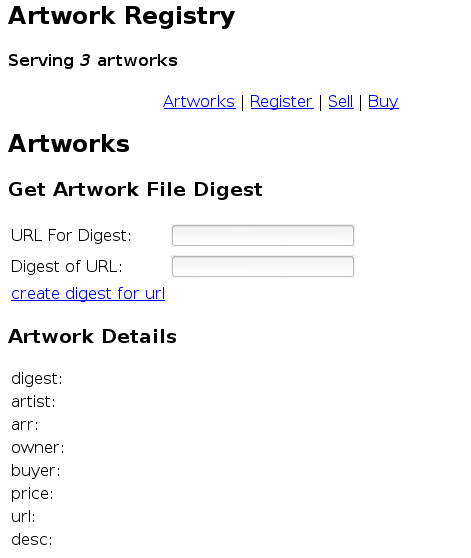
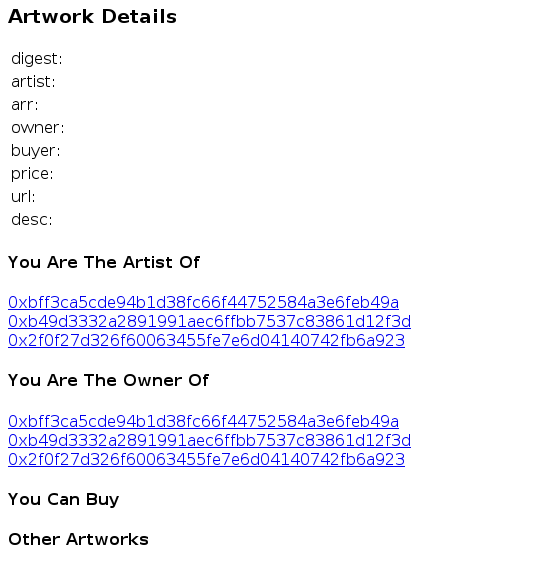 You can enter a URL and get the cryptographic hash for it.
You can enter a URL and get the cryptographic hash for it.
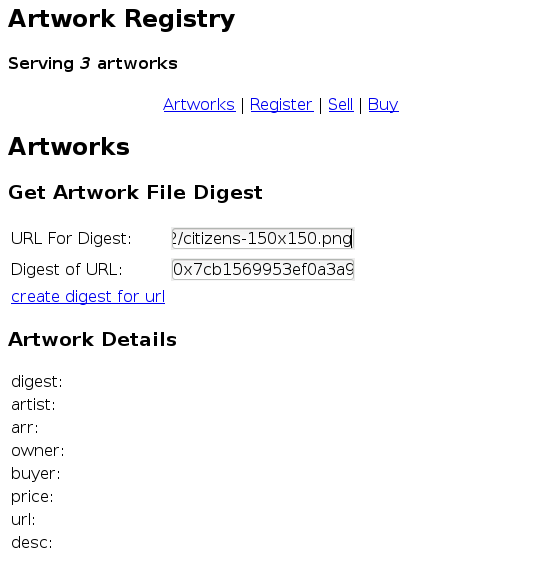 If the artwork has already been registered, this will show its details.
If the artwork has already been registered, this will show its details.
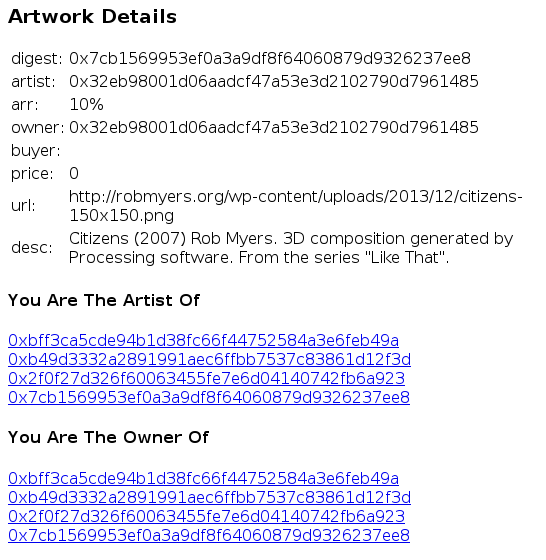 Or if not you can register it.
Or if not you can register it.
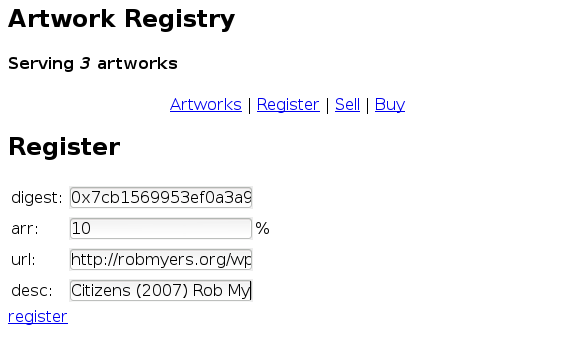 Once you’ve registered an artwork you are the artist of it and you also own it. You can offer any artwork you own for sale.
Once you’ve registered an artwork you are the artist of it and you also own it. You can offer any artwork you own for sale.
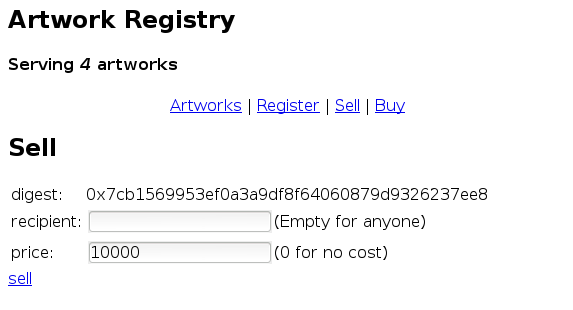 And you can accept a sale offer, paying the specified amount of Ether.
And you can accept a sale offer, paying the specified amount of Ether.
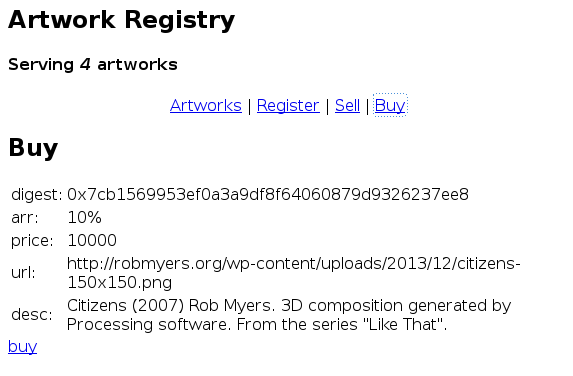 The UI warns you how much Ether you are about to spend.
The UI warns you how much Ether you are about to spend.
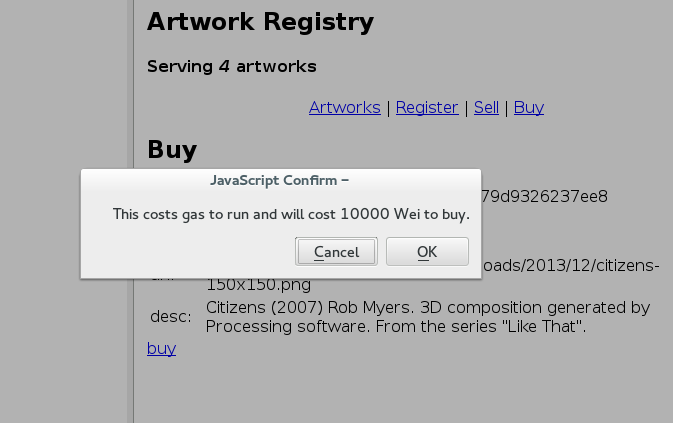 And when you buy an artwork it lets you know when the transfer is complete.
And when you buy an artwork it lets you know when the transfer is complete.
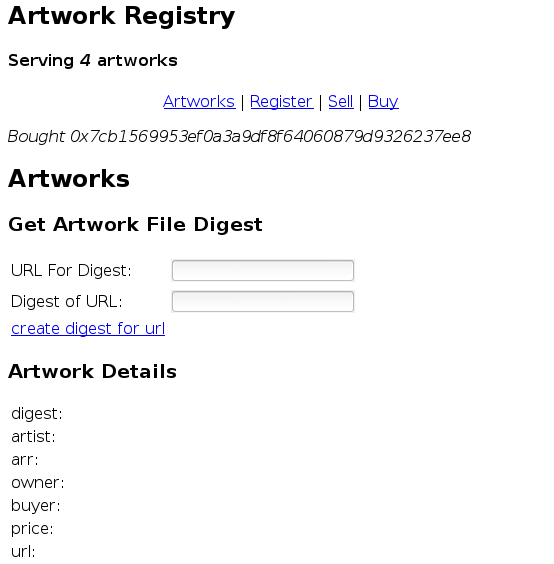 It’s a market in allographic digital art. In contrast to the existing art market it is entirely public and transparent. And in contrast to many jurisdictions it implements the controversial “Artist’s Resale Right” in a voluntary way (in a way similar to that suggested in “The Social Lives of Artistic Property”). If it’s prohibitively difficult to experiment in the existing art market, we can make new markets for new kinds of art. Like this one.
It’s a market in allographic digital art. In contrast to the existing art market it is entirely public and transparent. And in contrast to many jurisdictions it implements the controversial “Artist’s Resale Right” in a voluntary way (in a way similar to that suggested in “The Social Lives of Artistic Property”). If it’s prohibitively difficult to experiment in the existing art market, we can make new markets for new kinds of art. Like this one.